The document analyzes various compensation devices for power quality improvement in wind energy systems. It discusses three important compensating devices: the Dynamic Voltage Restorer (DVR), Unified Power Quality Conditioner (UPQC), and Distribution Static Compensator (DSTATCOM). It describes how each device works to mitigate common power quality issues like voltage sag, swell, and harmonics. Through modeling and analysis of how each device addresses these power quality problems, the document finds that the DSTATCOM performance is comparatively better and it is the most suitable device for power quality improvement in wind energy systems.

![M. Thirupathaiah, P. Venkata Prasad and V. Ganesh
http://www.iaeme.com/IJEET/index.asp 26 editor@iaeme.com
1. INTRODUCTION
Today’s technological world completely depends on electricity; however the
availability of electric sources are low. The deficiency of electricity becomes the
breaking point for developing countries like India. Hence the electric utilities are
finding a suitable solution for providing uninterruptable electricity. In this situation
the usage of renewable energy sources are the better solution, so these renewable
energy sources are encouraged for electricity production [1, 2]. In India, the most
available renewable source is wind and solar and the research on this area is under
progress [3, 4]. The wind based energy acquisition is most encouraging research area
because of its low complexity in installation and maintenance. In wind energy
acquisition the wind turbine is used [5]. The technical challenges that a power system
integrated with a wind power requires the analysis of power quality issues such as
voltage regulation and stability [6, 7]. The wind turbine produces a continuous
variable output. In wind power system, the wind turbine has a great importance to the
power quality issues in the power system [8, 9]. The variations in the power output
are caused due to wind groom and the disturbances in the power system [10].
Therefore, the system has to manage such variations so that the power quality issues
such as voltage sag, voltage swell, flickers and harmonics can be considered w.r.to the
generation, transmission and distribution systems of wind power [11].
But, the wind generation produces turbulence into the network. An induction
generator directly connected to the grid system can be used to run a wind generation
system [12]. Due to the variations in the wind, the active power generated by an
induction generator varies which affects the reactive power absorbed by the induction
generator and its terminal voltage [13]. In order to provide the control over the active
power produced by the induction generator, the wind generation system should work
with a précised control technique [14]. At point of common coupling (PCC), a
compensator device such as Distribution Static Compensator (DSTATCOM), Unified
Power Quality Conditioner (UPQC), Dynamic Voltage Restorer (DVR) & Static Var
Compensator (SVC) etc. can be connected for improving the power quality which can
manage the challenges of wind turbines [15].
2. POWER QUALITY ISSUES IN WIND ENERGY SYSTEM
The guidelines for measurement of power quality of wind turbine are developed by
The International Electro-technical Commission (IEC) in coordination with the
Technical Committee-88.This commission explained the methodologies for
measuring the power quality characteristics of a wind turbine [16]. For grid
connection, the base for the analysis is provided by the data sheet with electrical
characteristic of wind turbine.
2.1. Power Quality Issues
2.1.1. Voltage Variations
In wind generation system, the velocity of wind and the torque developed by the
generator results in the variations in the voltage. This voltage variation results in real
and reactive power variations. The fluctuations in the wind power occur during the
normal operation of the wind turbine. The magnitude of these fluctuations depends on
the impedance, phase angle, power factor of wind turbine and the strength of the grid.
Various types of voltage variations are given as follows:](https://image.slidesharecdn.com/ijeet0703003-160728080650/75/ANALYSIS-OF-VARIOUS-COMPENSATION-DEVICES-FOR-POWER-QUALITY-IMPROVEMENT-IN-WIND-ENERGY-SYSTEM-2-2048.jpg)
![Analysis of Various Compensation Devices For Power Quality Improvement In Wind Energy
System
http://www.iaeme.com/IJEET/index.asp 27 editor@iaeme.com
Voltage sag.
Voltage swells.
Voltage flicker.
Short interruptions.
Long duration voltage variation.
2.1.2. Harmonics
The harmonics in the wind power system is due to the usage of power electronic
equipment. At the connection point of the wind turbine to the system, the harmonic
voltages and currents should be within their limits. To ensure the voltage harmonics
within the limit, the current harmonics should contribute in a limited manner.
2.1.3. Wind Turbine Location & Self-Excitation of Wind Turbine
The quality of the power generated by the wind energy system depends on the way of
connecting the generation system into the network. Thus the location of the wind
turbine in power system influences the operation of the power system. In general, the
Wind Turbine Generating System (WTGS) is provided with a capacitor which results
in the risk of self excitation. The capacitor connected to the generator provides the
reactive power compensation. In Wind Turbine Generating System (WTGS), the self
excitation is provided by a synchronous generator immediately after disconnecting the
Wind Turbine Generating System (WTGS) with the load. But the major disadvantages
of self excitation are the imbalance between real and reactive power and the safety
[17].
2.2. Consequences
The issues mentioned above are the major causes to reduce the power quality of the
grid. The voltage variations such as voltage sag, swells, flickers, short and long
interruptions and harmonics causes the disoperation of the programmable logic
controllers and microprocessor based control systems. Also it results in tripping of
protective equipment such as circuit breakers, relays and contactors. Since the control
system consists of sensitive equipments like computers, microprocessors and PLCs,
the variation in the voltage leads to malfunction and sometimes even damage to this
sensitive equipment. Finally, due to this disoperation and malfunctioning of the
equipment the process may get stopped.
2.3. Grid Coordination
After the blackout in the United States in August 2003, the grid code was developed
by The American Wind Energy Association (AWEA) at the distribution level for
stable grid operation. The guidelines of grid operation of wind generating system at
the distribution system are defined as-per IEC-61400-21. The organization and
operation of interconnected system is governed by the operator of transmission grid
[18].
2.3.1. Voltage Swell/Rise
At the Point of Common Coupling (PCC), the voltage rise can be approximated as a
function of maximum apparent power maxS of the turbine, the phase angle and the
grid impedances R and X at the point of common coupling [19], given in eqn. (1).](https://image.slidesharecdn.com/ijeet0703003-160728080650/75/ANALYSIS-OF-VARIOUS-COMPENSATION-DEVICES-FOR-POWER-QUALITY-IMPROVEMENT-IN-WIND-ENERGY-SYSTEM-3-2048.jpg)
![M. Thirupathaiah, P. Venkata Prasad and V. Ganesh
http://www.iaeme.com/IJEET/index.asp 28 editor@iaeme.com
2
max sincos
U
XRS
u
(1)
Where u - Voltages rise
maxS - Maximum apparent power,
- Phase difference,
U - Nominal voltage of grid.
The limiting voltage rise value is < 2 %
2.3.2. Voltage Dip/Sag
The voltage dip or sag is a sudden reduction in the voltage due to the start of wind
turbine. It is mentioned in relative percentage voltage. The decrease in voltage is
given in eqn. (2).
K
n
u
S
S
Kd
(2)
Where d - Relative voltage change
uK - Sudden voltage reduction factor
nS - Rated apparent power
KS - Short circuit apparent power.
The limiting value of voltage dips is %3
2.3.3. Flicker
The voltage flicker measurements are done with more number of switching operations
of wind turbine, as given in eqn. (3).
K
n
Klt
S
S
CP (3)
Where KC - Flicker coefficient
ltP - Long term flicker
The Limiting Value for flicker coefficient is 4.0 [20]
2.3.4. Harmonics
At the point of common coupling, the harmonic distortion is measured for variable
speed turbine with an electronic power converter [21]. The total harmonic voltage
distortion of voltage is given as in eqn. (4):
%100
40
2 1
2
h
n
THD
V
V
V
(4)
Where, Vn - nth harmonic voltage
The THD limit for voltage is < 3 %
The THD of current THDI is given as in eqn. (5):](https://image.slidesharecdn.com/ijeet0703003-160728080650/75/ANALYSIS-OF-VARIOUS-COMPENSATION-DEVICES-FOR-POWER-QUALITY-IMPROVEMENT-IN-WIND-ENERGY-SYSTEM-4-2048.jpg)
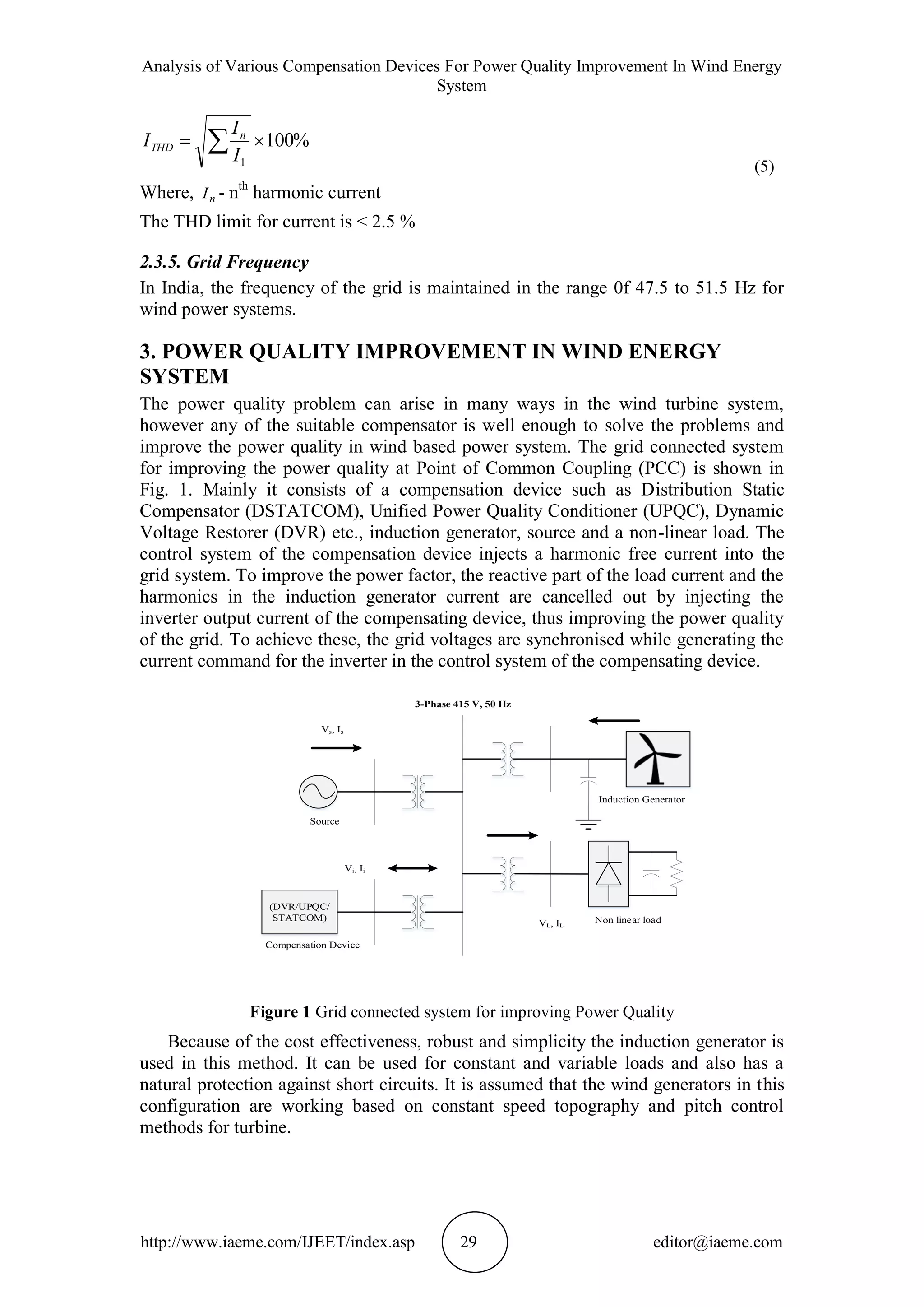

![Analysis of Various Compensation Devices For Power Quality Improvement In Wind Energy
System
http://www.iaeme.com/IJEET/index.asp 31 editor@iaeme.com
solutions for mitigation of major power quality problems [22].The UPQC which is an
integration of shunt and series APF is one of the most appropriate as well as effective
device in this concern [23]. A comprehensive review on the UPQC to enhance the
electric power quality for various type of power generation system at distribution and
transmission levels has been given in [24].
LOAD
Series
Inverter
Shunt
Inverter
UPQC
Figure 3 UPQC System Configuration
The main motive of UPQC is to solve the problems coming from both source side
and load side, such as voltage sag, voltage swell, harmonic reactive currents,
distortion in the supply voltage, etc., [25]. Using a common dc bus capacitor the
components of UPQC series and shunt inverter connected back to back. The general
block diagram representation of a UPQC based system is shown in Fig. 3.
3.3. Distribution Static Compensator (DSTATCOM)
Fig. 4 shows a typical DSTATCOM configuration. DSTATCOM is a Multiple Input
Multiple Output (MIMO) system. Thus a multivariable control approach is needed for
the DSTATCOM control design. There is one powerful tool for studying balanced
three phase system, which transform the three phase voltages and currents into
orthogonal components in a synchronous rotating frame by Park’s Transform but it is
not possible to totally decouple the system variables.](https://image.slidesharecdn.com/ijeet0703003-160728080650/75/ANALYSIS-OF-VARIOUS-COMPENSATION-DEVICES-FOR-POWER-QUALITY-IMPROVEMENT-IN-WIND-ENERGY-SYSTEM-7-2048.jpg)
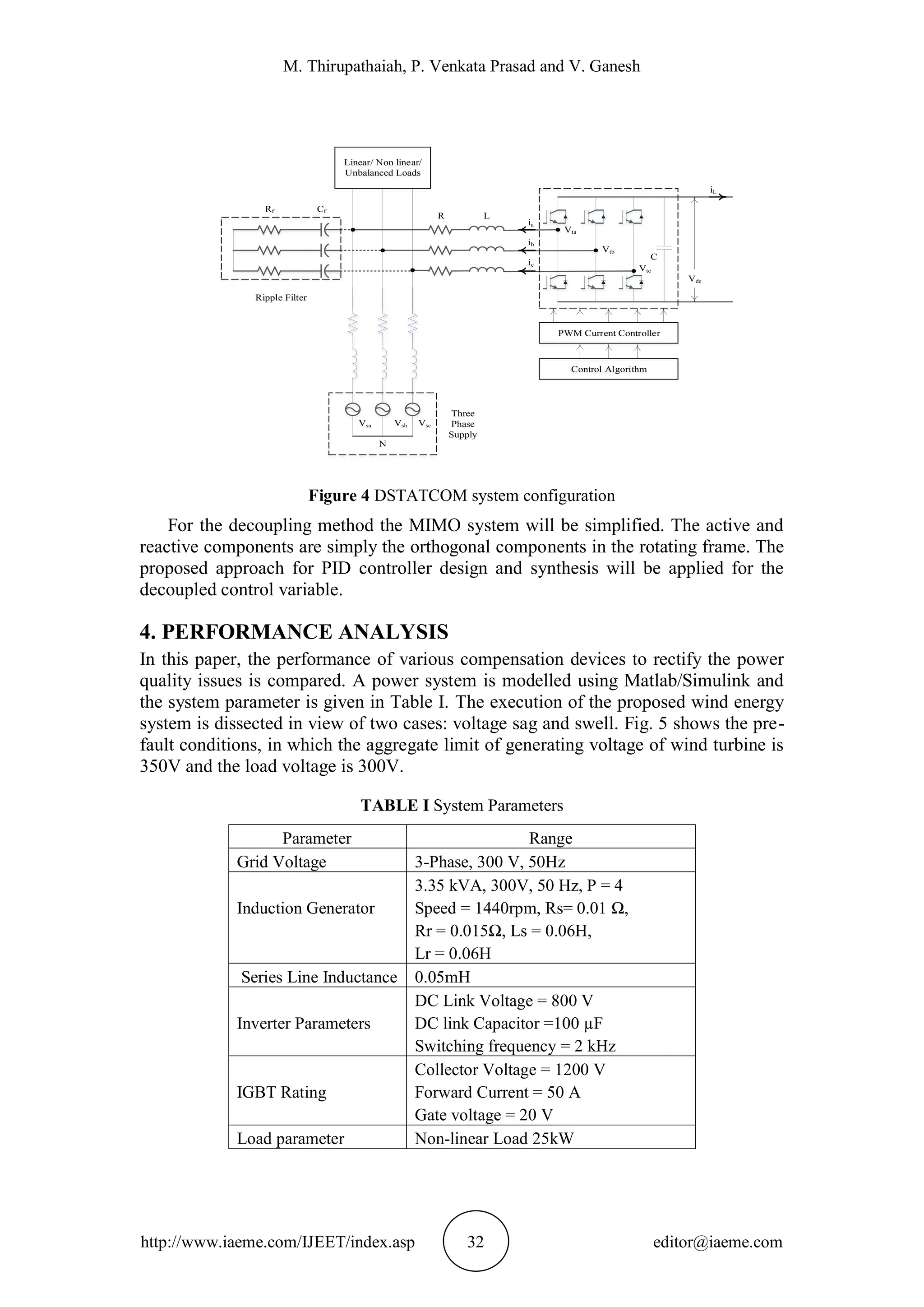
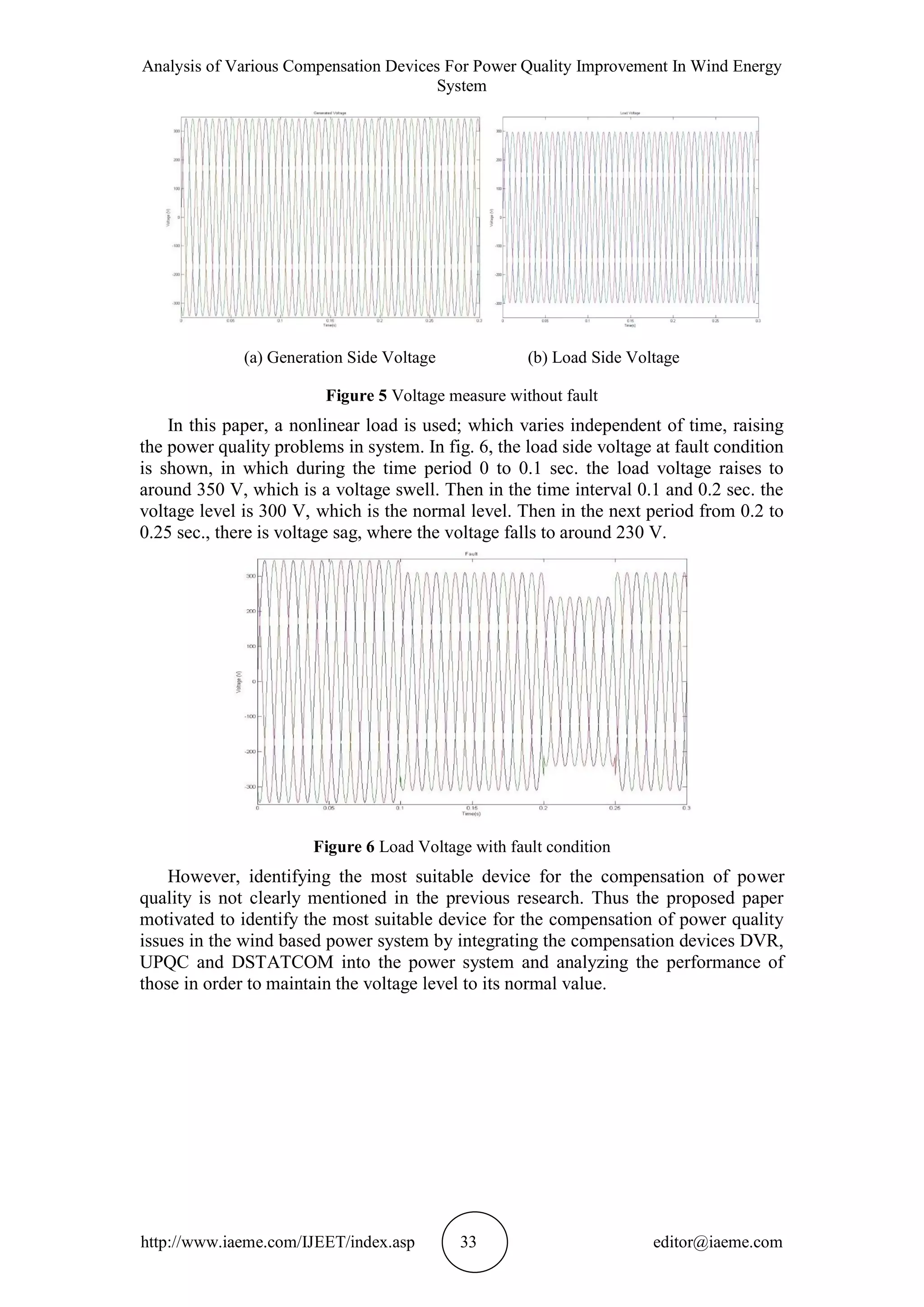
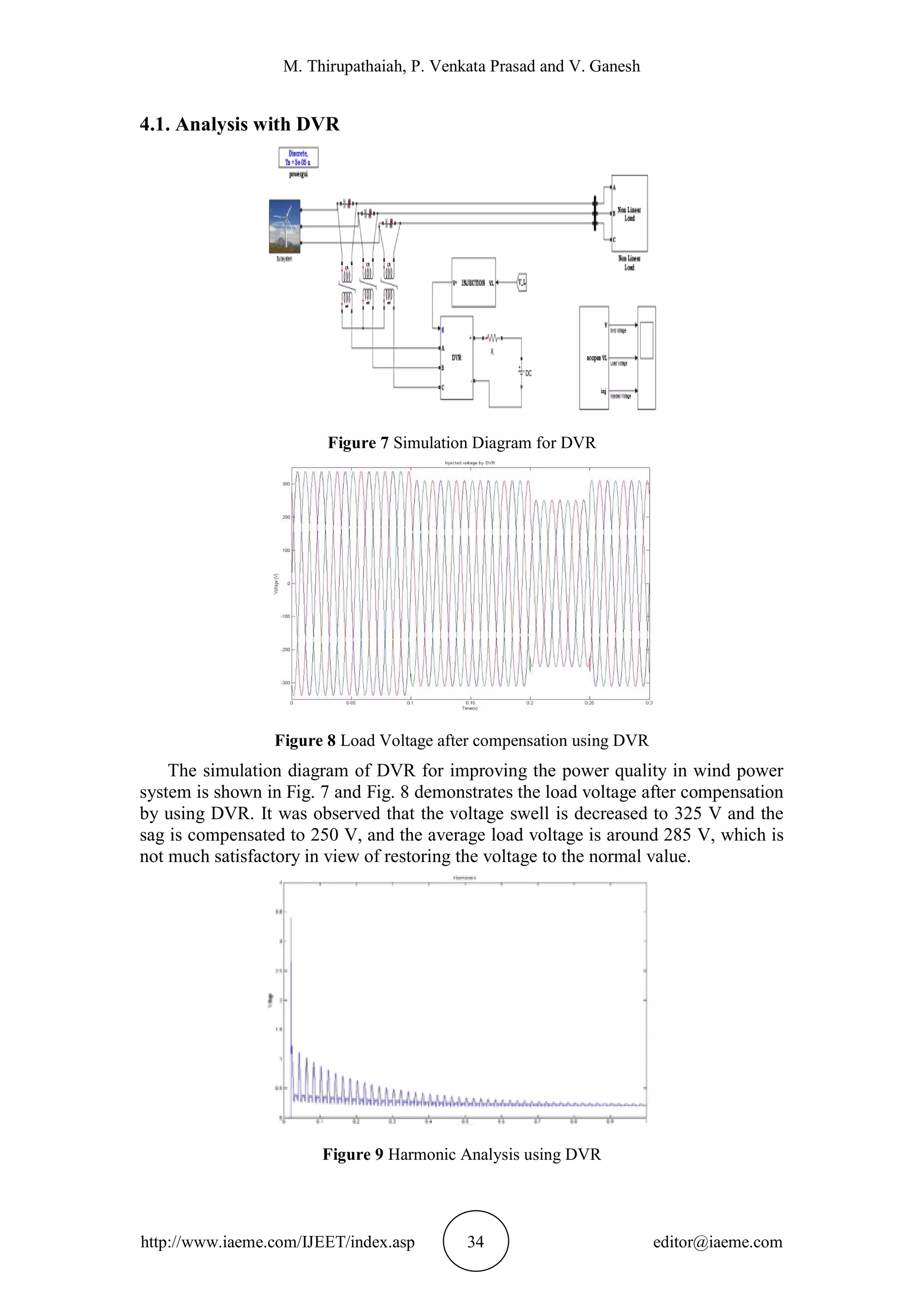
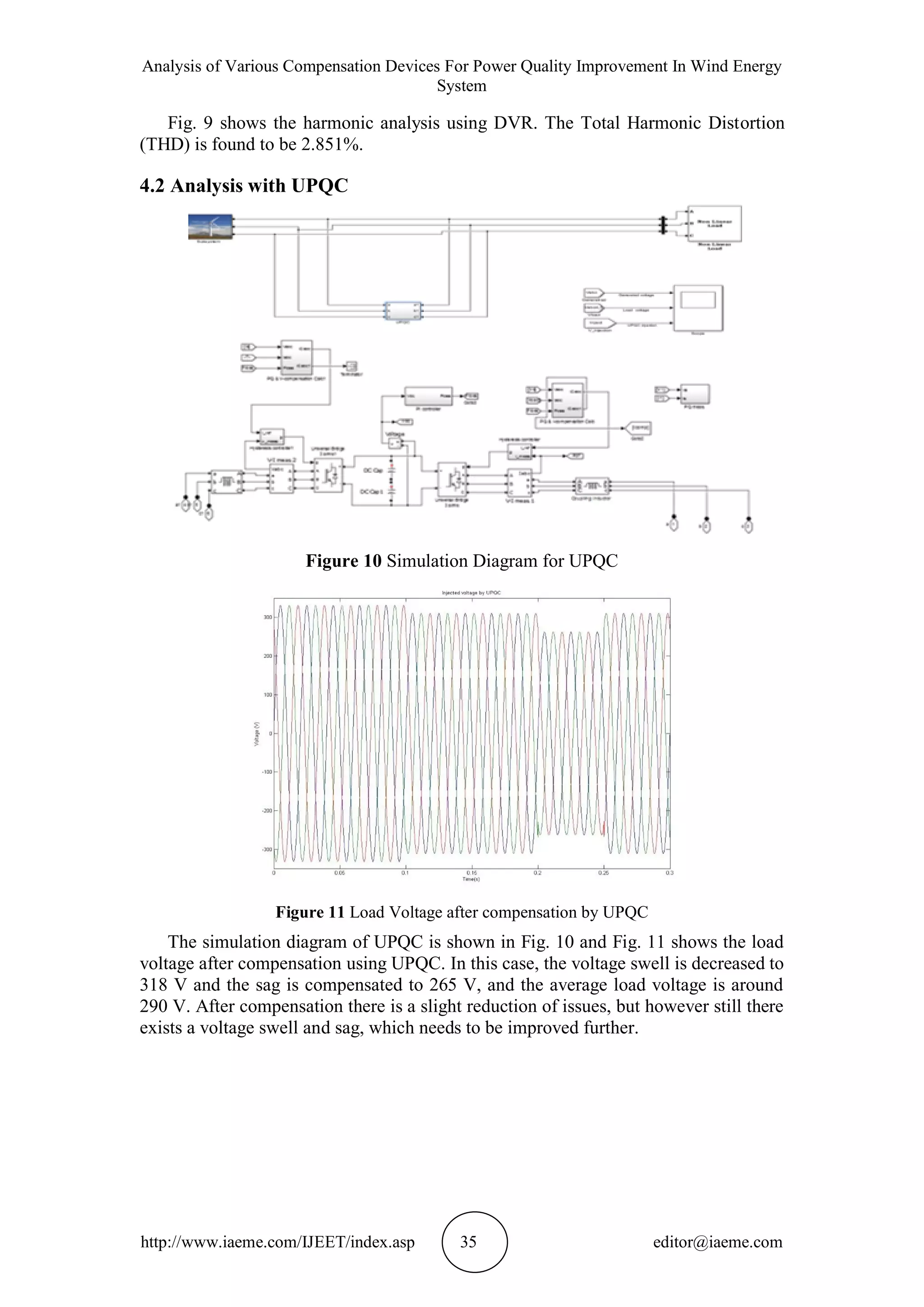
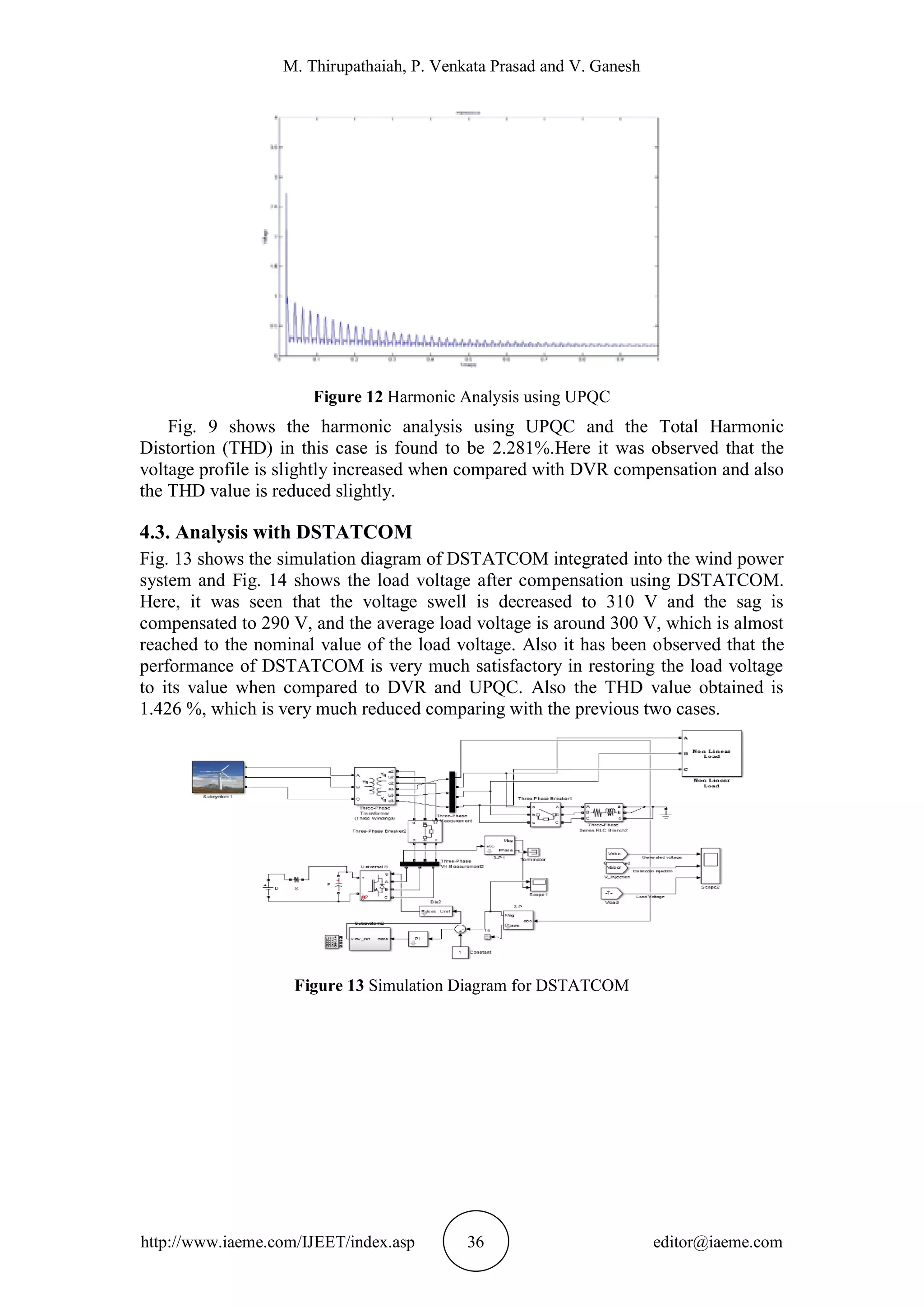

![M. Thirupathaiah, P. Venkata Prasad and V. Ganesh
http://www.iaeme.com/IJEET/index.asp 38 editor@iaeme.com
5. CONCLUSION
The power quality improvement in the distribution system integrated with a wind
turbine is one of the recent research trends. There are many devices used for the
power quality improvement, so it is tough to identify the most suitable device for the
power quality improvement in the distribution system. Hence, this paper presented the
analysis on three major compensation devices for power quality improvement, DVR,
UPQC and DSTATCOM. These three devices are analysed on a common problem in
wind based distribution system. The power quality is analysed based on the voltage
sag and swell measures, the implementation results and its analysis clearly shows the
betterment of the DSTATCOM. So, the DSTATCOM is the most suitable device
which can be used for wind energy system for power quality improvement. In future
scope, the modification of this DSTATCOM can be done to further enhance the
performance for improving the power quality in distribution systems.
REFERENCES
[1] Wanda J. Orlikowski and Jack J. Baroudi, Studying information technology in
organizations: Research approaches and assumptions, Information systems
research, 2(1), pp. 1–28, 1991.
[2] M.S. Dresselhaus and I.L. Thomas, Alternative energy technologies, Nature, 414,
(6861) pp. 332–337, 2001.
[3] Mark Z. Jacobson and Mark A. Delucchi, Providing all global energy with wind,
water, and solar power, Part I: Technologies, energy resources, quantities and
areas of infrastructure, and materials, Energy Policy, 39(3), pp. 1154-1169, 2011.
[4] Bert JM De Vries, Detlef P. van Vuuren, and Monique M. Hoogwijk, Renewable
energy sources: Their global potential for the first-half of the 21st
century at a
global level: An integrated approach, Energy policy, 35(4), pp. 2590–2610, 2007.
[5] Joanna I. Lewis, Technology acquisition and innovation in the developing world:
wind turbine development in China and India, Studies in comparative
international development, 42(3–4) pp. 208–232, 2007.
[6] Juan Manuel Carrasco, Leopoldo Garcia Franquelo, Jan T. Bialasiewicz, Eduardo
Galván, RC Portillo Guisado, Ma AM Prats, José Ignacio León, and Narciso
Moreno-Alfonso, Power- electronic systems for the grid integration of renewable
energy sources: A survey, IEEE Transactions on Industrial Electronics, 53(4), pp.
1002–1016, 2006.
[7] J.A. Lopes, N. Hatziargyriou, J. Mutale, P. Djapic, and N. Jenkins, Integrating
distributed generation into electric power systems: A review of drivers,
challenges and opportunities, Electric Power Systems Research, 77(9), pp. 1189–
1203, 2007.
[8] Carolina Vilar, Hortensia Amarís, and Julio Usaola, Assessment of flicker limits
compliance for wind energy conversion system in the frequency domain,
Renewable energy, 31(8), pp. 1089–1106, 2006.
[9] Jiyuan Fan and Stuart Borlase, The evolution of distribution, IEEE Power and
Energy Magazine, 7(2), pp. 63–68, 2009.
[10] Sharad W. Mohod and Mohan V. Aware, A STATCOM-control scheme for grid
connected wind energy system for power quality improvement, IEEE Systems
Journal, 4(3), pp. 346–352, 2010.
[11] Jos Arrillaga, Math HJ Bollen, and Neville R. Watson, Power quality following
deregulation, Proceedings of the IEEE, 88(2), pp. 246–261, 2000.](https://image.slidesharecdn.com/ijeet0703003-160728080650/75/ANALYSIS-OF-VARIOUS-COMPENSATION-DEVICES-FOR-POWER-QUALITY-IMPROVEMENT-IN-WIND-ENERGY-SYSTEM-14-2048.jpg)
![Analysis of Various Compensation Devices For Power Quality Improvement In Wind Energy
System
http://www.iaeme.com/IJEET/index.asp 39 editor@iaeme.com
[12] Rajib Datta and V. T. Ranganathan, A method of tracking the peak power points
for a variable speed wind energy conversion system, IEEE transactions on Energy
conversion, 18(1), pp. 163–168, 2003.
[13] Zhe Chen, Josep M. Guerrero, and Frede Blaabjerg, A review of the state of the
art of power electronics for wind turbines, IEEE Transactions on Power
Electronics, 24(8), pp. 1859–1875, 2009.
[14] Kelvin Tan, and Syed Islam, Optimum control strategies in energy conversion of
PMSG wind turbine system without mechanical sensors, IEEE Transactions on
Energy Conversion, 19(2), pp. 392–399, 2004.
[15] V. Yuvaraj, E. Pratheep Raj, A. Mowlidharan, and L. Thirugnanamoorthy, Power
quality improvement for grid connected wind energy system using FACTS
device, In Proceedings of IEEE Joint 3rd Int'l Workshop on Nonlinear Dynamics
and Synchronization & 16th International Symposium on Theoretical Electrical
Engineering, pp. 1–7. 2011.
[16] Wind Turbine Generating System-Part 21, International standard-IEC 61400-21,
2001.
[17] J. Manel, Power electronic system for grid integration of renewable energy
source: A survey, IEEE Trans. Ind. Electron., 53(4), pp. 1002–1014, 2006,
Carrasco.
[18] M. Tsili and S. Papathanassiou, A review of grid code technology requirements
for wind turbine, Proc. IET Renew. Power gen., 3, pp. 308–332, 2009.
[19] S. Heier, Grid Integration of Wind Energy Conversions. Hoboken, NJ: Wiley,
2007, pp. 256–259.
[20] J.J. Gutierrez, J. Ruiz, L. Leturiondo, and A. Lazkano, Flicker measurement
system for wind turbine certification, IEEE Trans. Instrum. Meas., 58(2), pp.
375–382, Feb. 2009.
[21] Indian Wind Grid Code Draft report on, Jul. 2009, pp. 15–18, C-NET.
[22] El-Habrouk M., Darwish M.K., Mehta P, Active power filters: a review, Electric
Power Applications, IEE Proceedings, 147(5), Sept. 2000, pp. 403–413.
[23] V. Khadkikar, A. Chandra, A. Barry and T.D. Nguyen, Conceptual Study of
Unified Power Quality Conditioner (UPQC), IEEE ISIE 2006, July 9–12, 2006,
Montreal, Quebec, Canada.
[24] Vinod Khadkikar, Enhancing Electric Power Quality Using UPQC: A
Comprehensive Overview, IEEE Transactions on Power Electronics, 27(5), pp.,
2012.
[25] K.Rama Lingeswara Prasad and Dr.K.Chandra Sekhar, A New Sensorless
Control Strategy For A Variable Speed PMSG Wind Energy System Connected
To Grid. International Journal of Electrical Engineering & Technology, 4(5),
2014, pp. 146–154.
[26] Aswathi.N.A, Sneha.M.L, Rashmi and Mohamed Jalaluddin, Power Quality
Improvement by Harmonic Reduction. International Journal of Electrical
Engineering & Technology, 5(8), 2015, pp. 222–232.
[27] S.Munisekhar, O.Hemakesavulu And Dr.M.Padmalalitha, Wind Energy
Conversion Systems Using Fuzzy Controlled Statcom For Power Quality
Improvement. International Journal of Electrical Engineering & Technology,
4(4), 2013, pp. 108–117.
[28] Zhang Hui, Liu Jinjun, Huang Xinming, and WANG Zhaoan, Design of A New
DC Link Voltage Controller for Universal Power Quality Controllers, IEEE
press, Applied power electronics conference, Feb. 25–March 1 2007, pp. 473–
477.](https://image.slidesharecdn.com/ijeet0703003-160728080650/75/ANALYSIS-OF-VARIOUS-COMPENSATION-DEVICES-FOR-POWER-QUALITY-IMPROVEMENT-IN-WIND-ENERGY-SYSTEM-15-2048.jpg)